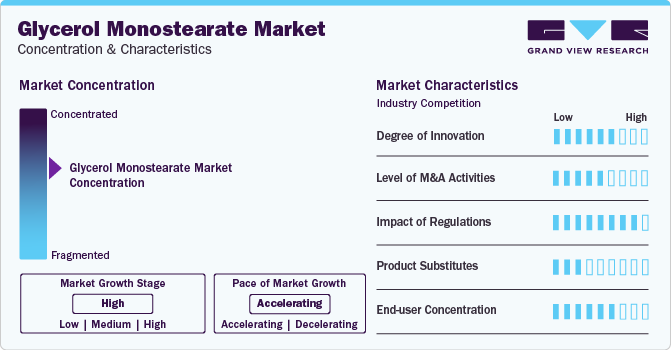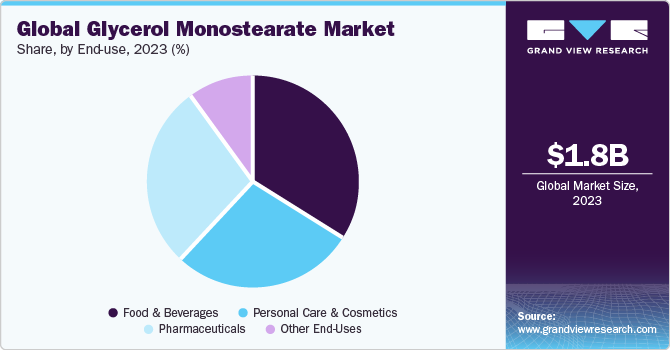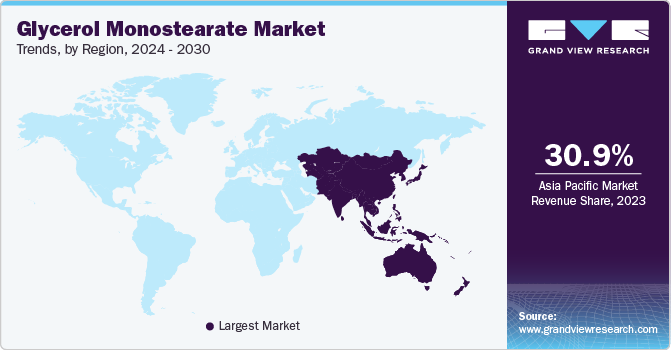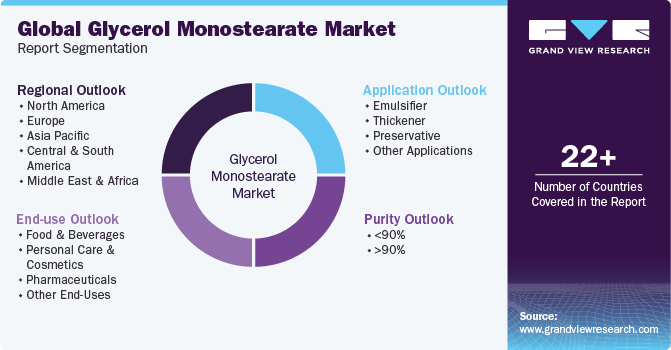- Home
- »
- Food Additives & Nutricosmetics
- »
-
Glycerol Monostearate Market Size And Share Report, 2030GVR Report cover
![Glycerol Monostearate Market Size, Share & Trends Report]()
Glycerol Monostearate Market Size, Share & Trends Analysis Report By Purity (<90%, >90%), By Application (Emulsifier, Thickener, Preservative), By End-use, By Region, And Segment Forecasts, 2024 - 2030
- Report ID: GVR-4-68040-196-5
- Number of Report Pages: 120
- Format: PDF, Horizon Databook
- Historical Range: 2018 - 2023
- Forecast Period: 2024 - 2030
- Industry: Specialty & Chemicals
Glycerol Monostearate Market Size & Trends
The global glycerol monostearate (GMS) market size was estimated at USD 1.75 billion in 2023 and is projected to grow at a compound annual growth rate (CAGR) of 6.2% from 2024 to 2030. The growth is primarily driven by the increasing demand for bio-based emulsifiers and the growing awareness regarding the benefits of glycerol monostearate in various end-user industries such as personal care & cosmetics, food & beverages, and pharmaceuticals. Manufacturers are investing in research and development (R&D) to enhance the quality, purity, and efficiency of glycerol monostearate, thereby expanding its potential applications. For instance, advancements in production processes have led to the availability of high-purity glycerol monostearate, which is preferred in pharmaceutical and food applications due to its compliance with stringent quality standards.

One of the key drivers of the GMS market in China is the rapid growth and evolution of the country's economy.Since China began to open up and reform its economy in 1978, its GDP growth has averaged almost 10% a year, leading to significant improvements in living standards and increased consumer spending power. This has resulted in a significant growth in demand for products offered by personal care & cosmetics industries as well as an increase in the consumption of processed food products. This phenomenon has led to an increase in the usage of GMS, thus acting as a major growth driver for the industry in China.
A notable opportunity for the glycerol monostearate market lies in the food and beverage sector, where glycerol monostearate is utilized as an emulsifier and stabilizer in the production of a wide range of products, including bakery items, dairy products, and confectionery. As consumers seek clean-label and sustainable products, the demand for glycerol monostearate in food applications is expected to rise, creating opportunities for manufacturers to expand their product offerings and cater to the evolving needs of the food industry.
The regulatory scenario for the GMS market is influenced by the standards and guidelines established by regulatory authorities such as the Food and Drug Administration (FDA) in the United States, European Food Safety Authority (EFSA) in the European Union. GMS is commonly used as an emulsifier, stabilizer, and thickening agent in various food and beverage products. As a result, regulatory standards play a crucial role in shaping the market landscape. For instance, the FDA regulates the use of glycerol monostearate as a food additive and sets specific limits on its application in food products to ensure consumer safety.
Market Concentration & Characteristics
The market is characterized by the presence of a few major players who dominate the industry. These players have a strong distribution network and extensive product portfolios, allowing them to cater to a wide range of applications and customers. This level of consolidation in the market creates barriers to entry for new players, as the established companies already have a strong foothold and brand recognition.For example, companies like Croda International plc, Oleon NV, and BASF SE are the major market players. These companies have a global presence and offer a wide range of glycerol monostearate products.

The GMS market is a thriving industry that plays a crucial role in various sectors such as food and beverages, cosmetics, pharmaceuticals, and personal care products. Glycerol monostearate, also known as GMS, is a versatile emulsifier and stabilizer that is widely used in these industries. Its ability to improve the texture, stability, and appearance of products has made it a popular ingredient. The market growth is driven by factors such as increasing consumer demand for convenience foods and the growing awareness of the benefits of natural and organic products.
One major factor that influences the market is the increasing demand for clean labels and natural ingredients. Consumers are becoming more conscious about the ingredients used in the products they consume, and they prefer products that are free from artificial additives and preservatives. Glycerol monostearate, being a natural substance derived from plant or animal sources, aligns well with this consumer trend. This demand for clean-label products has prompted manufacturers to incorporate glycerol monostearate in their formulations, thereby driving the market growth.
Regulations also play a vital role in the glycerol monostearate market. Governments and regulatory bodies impose standards and guidelines to ensure the safety and quality of products containing glycerol monostearate. These regulations include maximum usage limits, labeling requirements, and specifications for purity and quality. For instance, in the European Union, glycerol monostearate is regulated under the European Food Safety Authority (EFSA). It is approved as a food additive with specific usage levels and labeling requirements. Similar regulations exist in other regions as well, ensuring safety and quality standards.
Purity Insights
The <90% segment dominated the market and accounted for a revenue share of 84.1% in 2023. GMS with a purity of less than 90% contains impurities or lower levels of the desired compound. Impurities can vary depending on the production process and quality control measures. The inclusion of impurities in their chemical structure renders them different physical properties, such as melting and boiling points, than the pure form of GMS. Applications for GMS with less than 90% purity may still exist in fields where stringent GM purity requirements are not required.
The >90% pure GMS is the other major segment in GMS Market. It is composed of glycerol and stearic acid. It possesses a distinctive white hue and a waxy texture, accompanied by a subtle fragrance, and showcases the characteristics of being insoluble in water while demonstrating solubility in organic solvents. It is widely utilized across an array of industries including food, pharmaceuticals, and cosmetics, it fulfills essential roles as a stabilizer, thickening agent, and emulsifier.
The <90% glycerol monostearate finds applications in the food industry as it helps improve the texture, consistency, and shelf life of food products. In the baked goods segment, GMS is used in the production of baked goods such as bread, cakes, and pastries. It helps increase the volume of bakery products while enhancing the moisture retention of these products. GM is also employed in dairy products and confectionary items to prevent the formation of ice crystals and the separation of cocoa solids and cocoa butter, respectively.
Application Insights
Emulsifiers dominated the market and accounted for a revenue share of 40.7% in 2023. As an ester of stearic acid and glycerol, GMS has both hydrophilic and lipophilic characteristics, making it an efficient emulsifier. Its ability to form stable oil-in-water emulsions arises from its molecular structure, featuring a hydrophilic head and a lipophilic tail that blends with oily substances. This allows GMS to stabilize oil-water mixtures, preventing separation while also offering thickening properties that are valuable across various applications.
Glycerol monostearate is commonly utilized as a preservative in the food and cosmetics industries due to its ability to interact with oil and water and exhibit hydrophilic and lipophilic characteristics. This allows it to form stable emulsions and contribute to the preservation of products. Its ability to inhibit microbial growth and prevent spoilage makes it a valuable ingredient in food, pharmaceutical, and cosmetic products.
GMS also serves as an effective thickener in various industries due to its unique properties and mode of operation. GMS aligns its hydrophilic head toward water and its lipophilic tail toward oil, creating a stable interface between the two phases. This arrangement reduces interfacial tension, resulting in the formation of a thickened and stable product. GMS is commonly used as a thickener in ice cream, whipped toppings, and baked goods, as well as in cosmetic formulations like creams and lotions.
End-use Insights
Food & beverages dominated the market and accounted for a revenue share of 33.5% in 2023. Glycerol monostearate is used as a thickening agent, emulsifier, and preservative as well as an anticaking agent, in the food & beverages industry. The multifunctional nature of GMS has enabled them to become a widely used ingredient in various sub-industries within the food & beverages sector such as bakeries, beverages, packaged food, and others.

In the personal care and cosmetics industry, GMS finds application as a thickening agent. GMS is often utilized in lotions, creams, and moisturizers to provide a thicker and more luxurious feel. By acting as a thickening agent, GMS contributes to the stability and aesthetic appeal of these products. Glycerol monostearate also serves as a moisture agent in the personal care and cosmetics industry. It acts as a humectant, drawing moisture from the environment and binding it to the skin.
The pharmaceutical industry serves as a significant end-user of glycerol monostearate (GMS) where it is commonly used as a lubricant, stabilizer, and emulsifier. The GMS is employed to improve the wettability of drug particles by lowering the interfacial tension between the liquid and drug particles. This property is crucial in the formulation of oral suspensions, where GMS aids in the dispersion of active pharmaceutical ingredients (APIs) in the liquid vehicle, ensuring uniform distribution and consistent dosing.
Regional Insights
Asia Pacific dominated the market and accounted for a revenue share of 30.9% in 2023. This high share is attributable to industries present in the region. The major application scope for GMS includes pharmaceuticals, textiles, and paints & coatings. Large-scale industrial and economic growth in the region with leading economies such as India, China, Japan, and emerging countries such as Bangladesh and Vietnam have contributed to the GMS market in Asia Pacific.
North America is a major regional market for glycerol monostearate owing to the presence of major end-users in the region, along with a well-established food processing landscape fueled by the surged consumption of processed food. The well-developed pharmaceutical industry in North America has emerged as another large-scale end-user of glycerol monostearate as it is used to improve the emulsifying properties of drugs and medicines.

Europe is a significant market for glycerol monostearate, which is widely used as an emulsifier and stabilizer in various industries. Glycerol monostearate is commonly used in the food and beverages, personal care products, and pharmaceutical industries, as well as in various industrial applications. The growth of the regional market is driven by the rise in demand for GMS from the extensive personal care products and cosmetics industry of Europe.
Key Glycerol Monostearate Company Insights
The GMS market exhibits a consolidated nature with a few of the major companies of companies accounting for the majority of market share. It is characterized by the different initiatives by companies to increase their competitiveness and market share. These companies are actively engaged in strategic initiatives such as mergers & acquisitions, product developments, regional expansions, and innovations to strengthen their market position.
Some of the key market players include Croda International plc, Oleon NV, and Evonik Industries AG.
-
Croda International plc primarily deals in specialty chemicals meant for two markets, namely consumer care and life sciences. It also offers biotechnology solutions, segmented into fragrances, home care, personal care, and specialist solutions.
-
Oleon NV is an international company that specializes in the production and distribution of oleochemicals. The company is part of the Avril group, a recognized player in the bio-based chemistry sector. Oleon offers a wide range of products, including fatty acids, glycerin, esters, dimers, technical oils, and specialty oleo chemicals.
-
Estelle Chemicals Pvt. Ltd., Stepan Company, and Corbion are some of the emerging market participants.
-
Estelle Chemicals Pvt. Ltd. is a prominent manufacturer of food emulsifiers and specialty surfactants. It is a privately owned company that deals in the production of additives for use in the food & beverage industry.
-
Corbion is a key manufacturer of lactic acid, emulsifiers, minerals, vitamins, and functional enzyme blends, and algae ingredients. It is a publicly listed company on the Euronext Amsterdam stock exchange. The company has segmented its business into sustainable food solutions, algae ingredients, lactic acid & specialties, and incubators forming the core segment.
Key Glycerol Monostearate Companies:
The following are the leading companies in the glycerol monostearate market. These companies collectively hold the largest market share and dictate industry trends. Financials, strategy maps & products of these glycerol monostearate companies are analyzed to map the supply network.
- Alpha Chemicals Private Limited
- Kao Corporation
- Evonik Industries AG
- ACM Chemicals
- BASF SE
Recent Developments
-
In March 2023, Croda International plc, represented in India by its Indian subsidiary ‘ Croda India’, announced the decision to invest USD 5.4 million in building a greenfield manufacturing facility in Dahej, Gujarat. The new facility will aid in catering to the rising consumption of pharma and consumer care products.
-
In May 2022, Evonik Industries AG inaugurated its Applied Technology Center (ATC) in Sao Paulo, Brazil. The new facility would include new laboratories and two pilot plants, strengthening its interface & performance business line. Interface & Performance’s agro-business includes emulsifiers, wetting agents, antifoams, and dispersants. The facility is Evonik’s third regional Agro Hub after ones in the U.S. and Germany.
Glycerol Monostearate Market Report Scope
Report Attribute
Details
Market size value in 2024
USD 1.83 billion
Revenue forecast in 2030
USD 2.63 billion
Growth rate
CAGR of 6.2% from 2024 to 2030
Historical data
2018 - 2023
Forecast period
2024 - 2030
Quantitative units
Volume in kilo tons, revenue in USD million/billion and CAGR from 2024 to 2030
Report coverage
Volume forecast, revenue forecast, company ranking, competitive landscape, growth factors, and trends
Segments covered
Purity, application, end-use, region
Regional scope
North America; Europe; Asia Pacific; Central & South America; Middle East & Africa
Country scope
U.S.; Canada; Mexico; Germany; UK; France; Italy; Spain; China; Japan; India; South Korea; Brazil; Argentina; Colombia; Saudi Arabia; South Africa
Key companies profiled
Croda International Plc; Oleon NV; Stepan Company; Estelle Chemicals Pvt. Ltd.; Corbion; Alpha Chemicals Private Limited; Kao Corporation; Evonik Industries AG; acm chemicals; BASF SE
Customization scope
Free report customization (equivalent up to 8 analysts working days) with purchase. Addition or alteration to country, regional & segment scope.
Pricing and purchase options
Avail customized purchase options to meet your exact research needs. Explore purchase options
Global Glycerol Monostearate Market Report Segmentation
This report forecasts revenue growth at global, regional, and country levels and provides an analysis of the latest industry trends in each of the sub-segments from 2018 to 2030. For this study, Grand View Research has segmented the global glycerol monostearate market report based on purity, application, end-use, and region:

-
Purity Outlook (Volume, Kilo Tons; Revenue, USD Million, 2018 - 2030)
-
<90%
-
>90%
-
-
Application Outlook (Volume, Kilo Tons; Revenue, USD Million, 2018 - 2030)
-
Emulsifier
-
Thickener
-
Preservative
-
Other Applications
-
-
End-use Outlook (Volume, Kilo Tons; Revenue, USD Million, 2018 - 2030)
-
Food & Beverages
-
Personal Care & Cosmetics
-
Pharmaceuticals
-
Other End-Uses
-
-
Regional Outlook (Volume, Kilo Tons; Revenue, USD Million, 2018 - 2030)
-
North America
-
U.S.
-
Canada
-
Mexico
-
-
Europe
-
Germany
-
UK
-
France
-
Italy
-
Spain
-
-
Asia Pacific
-
China
-
Japan
-
India
-
South Korea
-
-
Central & South America
-
Brazil
-
Argentina
-
Colombia
-
-
Middle East and Africa
-
Saudi Arabia
-
South Africa
-
-
Frequently Asked Questions About This Report
b. The global glycerol monostearate market size was estimated at USD 1.75 billion in 2023 and is expected to reach USD 1.83 billion in 2024.
b. The global glycerol monostearate market is expected to grow at a compound annual growth rate of 6.2% from 2024 to 2030 to reach USD 2.63 billion by 2030.
b. Asia Pacific dominated the glycerol monostearate market with a share of 31.0% in 2023. This is attributable to industries present in the Asia Pacific with major application scope for GMS include pharmaceuticals, textiles, and paints & coatings.
b. Some key players operating in the glycerol monostearate market include Croda International Plc, Oleon NV, Stepan Company, Estelle Chemicals Pvt. Ltd., Corbion, Alpha Chemicals Private Limited, Kao Corporation, Evonik Industries AG, ACM chemicals, and BASF SE, among others.
b. Key factors that are driving the market growth include the increasing demand for bio-based emulsifiers and the growing awareness regarding the benefits of glycerol monostearate in various end-user industries such as personal care & cosmetics, food & beverages, pharmaceuticals and others.
Share this report with your colleague or friend.
![gvr icn]()
NEED A CUSTOM REPORT?
We can customize every report - free of charge - including purchasing stand-alone sections or country-level reports, as well as offer affordable discounts for start-ups & universities. Contact us now
![Certified Icon]()
We are GDPR and CCPA compliant! Your transaction & personal information is safe and secure. For more details, please read our privacy policy.
We are committed towards customer satisfaction, and quality service.
"The quality of research they have done for us has been excellent."





